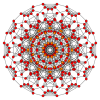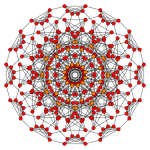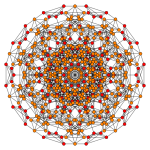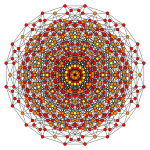Truncated 6-cubes
From Wikipedia, the free encyclopedia
In six-dimensional geometry, a truncated 6-cube (or truncated hexeract) is a convex uniform 6-polytope, being a truncation of the regular 6-cube.
 6-cube |
 Truncated 6-cube |
 Bitruncated 6-cube |
 Tritruncated 6-cube |
 6-orthoplex |
 Truncated 6-orthoplex |
 Bitruncated 6-orthoplex | |
| Orthogonal projections in B6 Coxeter plane | |||
|---|---|---|---|
There are 5 truncations for the 6-cube. Vertices of the truncated 6-cube are located as pairs on the edge of the 6-cube. Vertices of the bitruncated 6-cube are located on the square faces of the 6-cube. Vertices of the tritruncated 6-cube are located inside the cubic cells of the 6-cube.
Truncated 6-cube
Summarize
Perspective
| Truncated 6-cube | |
|---|---|
| Type | uniform 6-polytope |
| Class | B6 polytope |
| Schläfli symbol | t{4,3,3,3,3} |
| Coxeter-Dynkin diagrams | |
| 5-faces | 76 |
| 4-faces | 464 |
| Cells | 1120 |
| Faces | 1520 |
| Edges | 1152 |
| Vertices | 384 |
| Vertex figure |  ( )v{3,3,3} |
| Coxeter groups | B6, [3,3,3,3,4] |
| Properties | convex |
Alternate names
- Truncated hexeract (Acronym: tox) (Jonathan Bowers)[1]
Construction and coordinates
The truncated 6-cube may be constructed by truncating the vertices of the 6-cube at of the edge length. A regular 5-simplex replaces each original vertex.
The Cartesian coordinates of the vertices of a truncated 6-cube having edge length 2 are the permutations of:
Images
| Coxeter plane | B6 | B5 | B4 |
|---|---|---|---|
| Graph |  |
 |
 |
| Dihedral symmetry | [12] | [10] | [8] |
| Coxeter plane | B3 | B2 | |
| Graph |  |
 | |
| Dihedral symmetry | [6] | [4] | |
| Coxeter plane | A5 | A3 | |
| Graph |  |
 | |
| Dihedral symmetry | [6] | [4] |
Related polytopes
The truncated 6-cube, is fifth in a sequence of truncated hypercubes:
| Image |  |
  |
  |
  |
  |
  |
  |
... |
|---|---|---|---|---|---|---|---|---|
| Name | Octagon | Truncated cube | Truncated tesseract | Truncated 5-cube | Truncated 6-cube | Truncated 7-cube | Truncated 8-cube | |
| Coxeter diagram | ||||||||
| Vertex figure | ( )v( ) |  ( )v{ } |
 ( )v{3} |
 ( )v{3,3} |
( )v{3,3,3} | ( )v{3,3,3,3} | ( )v{3,3,3,3,3} |
Bitruncated 6-cube
Summarize
Perspective
| Bitruncated 6-cube | |
|---|---|
| Type | uniform 6-polytope |
| Class | B6 polytope |
| Schläfli symbol | 2t{4,3,3,3,3} |
| Coxeter-Dynkin diagrams | |
| 5-faces | |
| 4-faces | |
| Cells | |
| Faces | |
| Edges | |
| Vertices | |
| Vertex figure |  { }v{3,3} |
| Coxeter groups | B6, [3,3,3,3,4] |
| Properties | convex |
Alternate names
- Bitruncated hexeract (Acronym: botox) (Jonathan Bowers)[2]
Construction and coordinates
The Cartesian coordinates of the vertices of a bitruncated 6-cube having edge length 2 are the permutations of:
Images
| Coxeter plane | B6 | B5 | B4 |
|---|---|---|---|
| Graph |  |
 |
 |
| Dihedral symmetry | [12] | [10] | [8] |
| Coxeter plane | B3 | B2 | |
| Graph |  |
 | |
| Dihedral symmetry | [6] | [4] | |
| Coxeter plane | A5 | A3 | |
| Graph |  |
 | |
| Dihedral symmetry | [6] | [4] |
Related polytopes
The bitruncated 6-cube is fourth in a sequence of bitruncated hypercubes:
| Image |   |
  |
  |
  |
  |
  |
... |
|---|---|---|---|---|---|---|---|
| Name | Bitruncated cube | Bitruncated tesseract | Bitruncated 5-cube | Bitruncated 6-cube | Bitruncated 7-cube | Bitruncated 8-cube | |
| Coxeter | |||||||
| Vertex figure |  ( )v{ } |
 { }v{ } |
 { }v{3} |
 { }v{3,3} |
{ }v{3,3,3} | { }v{3,3,3,3} |
Tritruncated 6-cube
Summarize
Perspective
| Tritruncated 6-cube | |
|---|---|
| Type | uniform 6-polytope |
| Class | B6 polytope |
| Schläfli symbol | 3t{4,3,3,3,3} |
| Coxeter-Dynkin diagrams | |
| 5-faces | |
| 4-faces | |
| Cells | |
| Faces | |
| Edges | |
| Vertices | |
| Vertex figure |  {3}v{4}[3] |
| Coxeter groups | B6, [3,3,3,3,4] |
| Properties | convex |
Alternate names
- Tritruncated hexeract (Acronym: xog) (Jonathan Bowers)[4]
Construction and coordinates
The Cartesian coordinates of the vertices of a tritruncated 6-cube having edge length 2 are the permutations of:
Images
| Coxeter plane | B6 | B5 | B4 |
|---|---|---|---|
| Graph |  |
 |
 |
| Dihedral symmetry | [12] | [10] | [8] |
| Coxeter plane | B3 | B2 | |
| Graph |  |
 | |
| Dihedral symmetry | [6] | [4] | |
| Coxeter plane | A5 | A3 | |
| Graph |  |
 | |
| Dihedral symmetry | [6] | [4] |
Related polytopes
| Dim. | 2 | 3 | 4 | 5 | 6 | 7 | 8 | n |
|---|---|---|---|---|---|---|---|---|
| Name | t{4} | r{4,3} | 2t{4,3,3} | 2r{4,3,3,3} | 3t{4,3,3,3,3} | 3r{4,3,3,3,3,3} | 4t{4,3,3,3,3,3,3} | ... |
| Coxeter diagram |
||||||||
| Images |  |
  |
  |
  |
  |
  |
  | |
| Facets | {3} {4} |
t{3,3} t{3,4} |
r{3,3,3} r{3,3,4} |
2t{3,3,3,3} 2t{3,3,3,4} |
2r{3,3,3,3,3} 2r{3,3,3,3,4} |
3t{3,3,3,3,3,3} 3t{3,3,3,3,3,4} | ||
| Vertex figure |
( )v( ) |  { }×{ } |
 { }v{ } |
 {3}×{4} |
 {3}v{4} |
{3,3}×{3,4} | {3,3}v{3,4} |
Related polytopes
These polytopes are from a set of 63 Uniform 6-polytopes generated from the B6 Coxeter plane, including the regular 6-cube or 6-orthoplex.
Notes
References
External links
Wikiwand - on
Seamless Wikipedia browsing. On steroids.































































